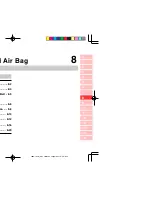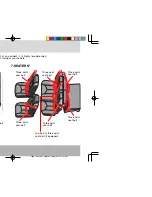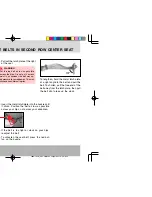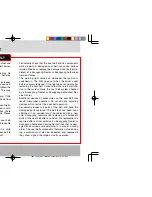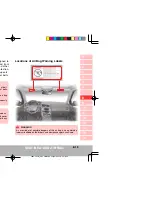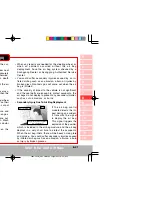
SEAT BELT AND AIR BAG
8-11
0
1
2
3
4
5
6
7
8
9
10
11
12
13
14
15
16
WARNINGS FOR SEAT BELT
• Replace the entire seat belt assembly after a severe im-
pact even if the damage is not obvious.
• Never modify the seat belt.
• Always keep the seat belts clean and dry. Care should be
taken to avoid contamination of the webbing with polishes,
oil and chemicals, and particularly battery acid. Use mild
soap and water for cleaning. The seat belt must be replaced
if webbing becomes frayed, contaminated or damaged.
• Adjust the seat properly before wearing the seat belt.
• Sit back in the seat with the seatback in an upright posi-
tion and wear the seat belt. If the seat belt is positioned
too high or fastened too loose, it may not protect your
body from an injury or death in the event of a collision.
• Do not recline the seatback more than needed for com-
fort while vehicle is in use. Seat belt is the most effective
when the passenger sits back and straight up in the seat.
If the seatback is reclined too much, then the risks of
sliding under the lap belt and getting injured are increased.
• If the latch plate is inserted into a wrong buckle, the belt
may exert pressure on your abdomen instead of your
pelvis. This may cause serious internal injury.
• If the seat belt is twisted, there will not be enough con-
tact of the belt to spread the impact pressure.
• Make sure that the latch plate is securely locked.
• When pregnant women use the seat belt, consult with a
doctor for specific recommendations.
• Keep the buckle clean.
• Seat belts are designed to bear upon the bony structure
of the body, and should be worn low across the front of
the pelvis or the hips, chest and shoulders, as applicable;
wearing the lap section of the belt across the abdominal
area must be avoided.
• Seat belts should be adjusted as firmly as possible, con-
sistent with comfort, to provide the protection for which
they have been designed. A slack belt will greatly re-
duce the protection afforded to the wearer.
• Care should be taken to avoid contamination of the web-
bing with polishes, oils and chemicals, and particularly
battery acid. Cleaning may safely be carried out using
mild soap and water. The belt should be replaced if web-
bing becomes frayed, contaminated or damaged.
• It is essential to replace the entire assembly after it has
been worn in a severe impact even if damage to the as-
sembly is not obvious.
• Belts should not be worn with straps twisted.
• Each belt assembly must only be used by one occupant;
it is dangerous to put a belt around a child being carried
on the occupant’s lap.
• No modifications or additions should be made by the
user which will either prevent the seat belt adjusting de-
vices from operating to remove slack, or prevent the seat
belt assembly from being adjusted to remove slack.
D146_08-Seat Belt and Air Bag.p65
2009-12-30, ¿ÀÀü 3:22
Page 11
Adobe PageMaker 6.5K/Win





